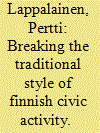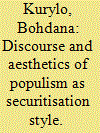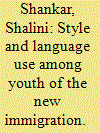|
|
|
Sort Order |
|
|
|
Items / Page
|
|
|
|
|
|
|
| Srl | Item |
| 1 |
ID:
101285


|
|
|
|
|
| Publication |
2010.
|
| Summary/Abstract |
Sudhir Venkatesh and Steven Levitt's influential 2000 article transformed the way social scientists study gangs by showing the context in which Chicago gang members built an organization modeled on a corporation. But if this research helped to demonstrate that the underground economy is a logical response to the inner city's isolation from the rest of the country, it also makes it difficult to see that the very same factors that have led to urban decay and "social isolation" (i.e., escalating unemployment, the loss of manufacturing jobs, and the emergence of gangs to fill bureaucratic voids) serve to connect gangs to wider social worlds. This study expands upon recent gang research by detailing the improvisational economic and social practices, as well as the intricate narratives, and the social practices that allow Chicago gangs and their members to access a variety of people, institutions, and resources, while marking the diverse modes of historical consciousness that gang affiliates develop. A gang that I will here be calling the "Divine Aces" forms a powerful case in point
|
|
|
|
|
|
|
|
|
|
|
|
|
|
|
|
| 2 |
ID:
102772


|
|
|
| 3 |
ID:
184050


|
|
|
|
|
| Summary/Abstract |
Populists have lately been at the forefront of securitisation processes, yet little attention has been paid to the relationship between populism and securitisation. This paper investigates the role of securitisation in populism, exploring how the populist mode of securitising differs from traditional securitisation processes. It argues that securitisation is inherently embedded in populism which embodies a particular style of securitisation with a distinct set of discursive and aesthetic repertoires. The populist invocation of societal security and their claim to defend the fundamentally precarious identity of ‘the endangered people’ necessitate an unceasing construction of new threats. Aiming to discredit ‘elitist’ securitisation processes, populism invests in a specific construction of the referent object, the securitising actor and their relationship to the audience. The populist securitising style also carries a distinctive aesthetic centred on ‘poor taste’, sentimental ordinariness and unprofessionalism, examining which can widen our understanding of the aesthetics of security.
|
|
|
|
|
|
|
|
|
|
|
|
|
|
|
|
| 4 |
ID:
164283


|
|
|
|
|
| Summary/Abstract |
What does it mean to study security from a critical perspective? This question continues to haunt critical security studies. Conversations about normative stances, political engagement, and the role of critique are mainstays of the discipline. This article argues that these conversations tend to revolve around a too disembodied image of research, where the everyday practice of researchers is sidelined. But researchers do do research: they work materially, socially, and cognitively. They mediate between various feedback loops or fields of critique. In doing so, they actively build and exercise critique. Recognizing that fact, this article resists growing suggestions to abandon critique by, first, returning to the practice of critique through the notion of companionship. This permits us to reinvigorate our attention to the objects, persons, and phenomena through which critique gains inspiration and purpose, and that literally accompany our relationship to critique. Second, we explore what happens when our companions disagree, when critique faces controversies and (a) symmetries. Here, we support research designs of tracing credibility and establishing symmetries in order to move away from critique as denouncing positions we disagree with. Third, we discuss the relation between companionship, critique, reflexivity, and style. Here, the rhetorical practices of critical inquiry are laid out, and possibilities for its articulation in different and less silencing voices are proposed.
|
|
|
|
|
|
|
|
|
|
|
|
|
|
|
|
| 5 |
ID:
113901


|
|
|
|
|
| Publication |
2011.
|
| Summary/Abstract |
In this article I consider "style" as a linguistic and cultural concept that can demonstrate how identities performed through language use are linked to topics of central concern in studies of immigrant youth, including racial and ethnic formation, generational cohorts, acculturation, assimilation, and gender. I draw on anthropological and sociolinguistic approaches to style not generally considered in migration studies and present ethnographic data of two cliques of Desi (South Asian American) teens in a Northern California high school. I argue that analyses of youth style can substantially complicate assimilation frameworks by highlighting the ways in which young peoples' linguistic practices may not fit neatly into commonly used analytical categories of "immigrant" and "American." Focusing on how political economy and local histories inform power and difference that shape migration experiences for youth, the article moves beyond routinely examined areas of heritage language retention and loss to analyze the significance of youth performances of heritage languages as well as English.
|
|
|
|
|
|
|
|
|
|
|
|
|
|
|
|
|
|
|
|
|